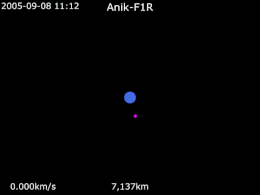Anik (satellite)
The naming of the satellite was determined by a national contest, and was won by Julie-Frances Czapla of Saint-Léonard, Québec.)[7] The Anik A fleet of three satellites gave CBC the ability to reach the Canadian North for the first time.[12] Anik C3 was used to distribute Canada's first pay television networks -- First Choice, Superchannel, C-Channel, Star Channel, AIM Pay-TV since February 1983.At 01:00 UTC, both the primary and redundant Anik E2 momentum wheels failed, thus eliminating the gyroscope effect that helps keep the satellite pointed correctly towards Earth.Telesat ultimately restored Anik E2 by constructing special earth stations at each end of the country to monitor the satellite's position, and designed specialised software to use a combination of its control jets and magnetic torquing coils to finely position the satellite.A critical diode on Anik E1's solar panel shorted out, causing a permanent loss of half the satellite's power.[15] Anik F1 is a Canadian geosynchronous communications satellite that was launched on November 21, 2000, by an Ariane 4 rocket from the European Space Agency Centre Spatial Guyanais at Kourou.At 5,900 kilograms (13,000 lb), it is more than ten times the size of Anik A2 and is one of the largest, most powerful communications satellites ever built.Anik F2 is a Boeing 702-series satellite, designed to support and enhance current North American voice, data, and broadcast services with its C-Band and Ku-band technologies.According to SatNews Publishers, Anik F3 is a 4,634 kilograms (10,216 lb) broadcasting and telecommunications satellite which will provide direct-to-home television in the United States, broadband Internet and telecommunications for Bell Canada, and broadcast TV in northern and other remote areas of Canada.It is also the first commercial satellite with a substantial X-band payload, for government communications from 178˚W to 35˚W covering the Americas and the Pacific Ocean, including Hawaii.



satellitesgeostationarycommunications satellitesTelesat Canadatelevisiongraveyard orbitSaint-Léonard, QuébecInuktitutHughes Aircraft HS-333Delta 1914Delta 2914Delta 3914Hughes Aircraft HS-376Space ShuttleDiscoveryChallengerColumbiaDelta 3920Ariane 44PHS 702Ariane 44LBoeing 702Ariane 5 GEurostar E3000Proton M / Briz-MSSL 1300Intelsat IC-bandtranspondersCNCP TelecommunicationsBell CanadaCanadian Overseas TelecommunicationsHermesCommunications Technology SatelliteCBC TelevisionCBC NorthCBC Parliamentary Television NetworkCITV-TVTVOntarioThe Globe and MailKu-bandpay televisionC-ChannelAtlantic Satellite NetworkSuper ÉcranRadio-QuébecKnowledgeAccess AlbertaPremier Choix/TVECLegislature ChannelKnowledge NetworkHS-3763-axisgyroscopecircuitrymomentum wheelNorthwestelnorthern CanadaGeostationary transfer orbitgeosynchronouscommunications satelliteAriane 4European Space AgencyCentre Spatial GuyanaisKourouxenon ion thruster propulsion systemCentral AmericaNorth AmericaCanadian Broadcasting CorporationShaw DirectCHUM LimitedCanadian Satellite Communications Inc.Bell Canada Enterprise Inc.Boeing Satellite SystemsHughes Aircraft CompanyLaunch vehicleSouth AmericaKa bandInternet accesstelehealthdistance educationremote worke-commerceQuébecDefence Research and Development CanadaXplornetSSI MicroShaw Direct Satellite TVAMC-11direct-to-home televisionbroadband InternettelecommunicationsEADS AstriumProton-MInternational Launch ServicesDirecTVBaikonur CosmodromeTelesatSpace Systems/LoralLS1300Edirect-to-homeX-band payloadAmericasPacific OceanHawaiiMinistry of DefenceSkynetBibcodeCBC NewsSpace.comWayback Machinefootprint(s)EchoStarDish NetworkSling TVBlockbusterEmergency Response Information NetworkSling MediaG4 MediaThe Weather CastTechTVDTVPalHopperPocketDishSlingboxSuperDish